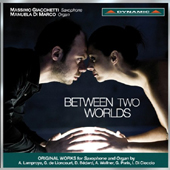
COLLECTIONS

1} André Lamproye - Hommage à Saint-Hadelin
2} Guy de Lioncourt - Trois Mélodies Grégoriennes
3} Denis Bédard - Sonate I
4} Alarich Wallner - Ludium I, II, III
5} Giorgio Paris - Alio modo - Ricercare sulla sequenza "Dies Irae" di T. da Celano
6} Italo Di Cioccio - Dialogue
A captivating collection of original compositions written specifically to bring together the complementary sounds of the saxophone and the pipe organ. An engrossing combination that through
reciprocal support, enhances the tone of each instrument. Both saxophonist Massimo Giacchetti and organist Manuela Di Marco hold a master degree in
their respective instrument, as well as studies in jazz, which translates into a playing style that merges the discipline of academia with the freedom of improvisation. Manuela Di Marco plays on
the Mascioni Organ Op. 1016 (1978) in the church of S. Alessandro, Barzio, and both the soprano and alto saxophones are Selmer instruments. They both spent a few years researching and mastering
the works by contemporary composers gathered together on this new recording.
The Hommage à Saint-Hadelin by Belgian composer André Lamproye (1931-2005) combines the regal with the rhapsodic. Laid out over six
movements, it seems to cover everything from the ceremonial to the melancholic to great effect. The flexible and malleable pitch of the soprano saxophone set against the just pitch of the organ
pipes creates a distinctive, living sound, and yet the saxophone could also be viewed as simply an extension of the organ's reed pipes. Wait 'til you hear the first movement's final high G of the saxophone
soaring high over the full organ. Magnificent! The Trois Mélodies Grégoriennes by Guy de Lioncourt (1885-1961) brings to mind the Jan Garbarek/Hilliard Ensemble
collaboration CD titled 'Officium' from around twenty years ago. It blends the beauty and fluidity of the monophonic Gregorian line, this time on the alto sax, with a variating harmonic background texture set by the organ.
Canadian composer and organist Denis Bédard (b 1950), sets out in his short three-movement Sonate I to disclose both the saxophone's mellow
and blue side, as well as its brilliant virtuosity. This work's central Barcarolle is a beauty to hear and a perfect example of how well these two instruments can mesh. On the other hand,
the piece by Giorgio Paris (b 1961) brings out the instrument's solo nature and free-flowing improvisational qualities as it ponders over the centuries old 'Dies Irae'. The spontaneous
and impulsive aspects of jazz are at play within the three movement Dialogue by Italian composer Italo Di Cioccio (b 1953). It demands a more proactive
interplay between both performers, and it certainly brings this CD to a lively and spirited conclusion.
The pipe organ and the saxophone are related to each other in that both are wind instruments, but yet they each have a very distinct personality and temperament. One is stoic while the other is
responsive. One is associated with the church while the other is associated with nightclubs. One is old and the other young. Sacred and profane. Lofty and humble. Put them together and they
instantly seem to become old friends and enhance each other's character. The same can be said for Massimo Giacchetti and Manuela Di Marco. They seem
to intuitively play off of each other and in doing so project a bold and yet natural sound from this new and nonconforming alliance. Plaudits to the people at Dynamic for going
out on a limb and producing this recording which presents us world première releases of the performers, works and composers.
Jean-Yves Duperron - July 2012